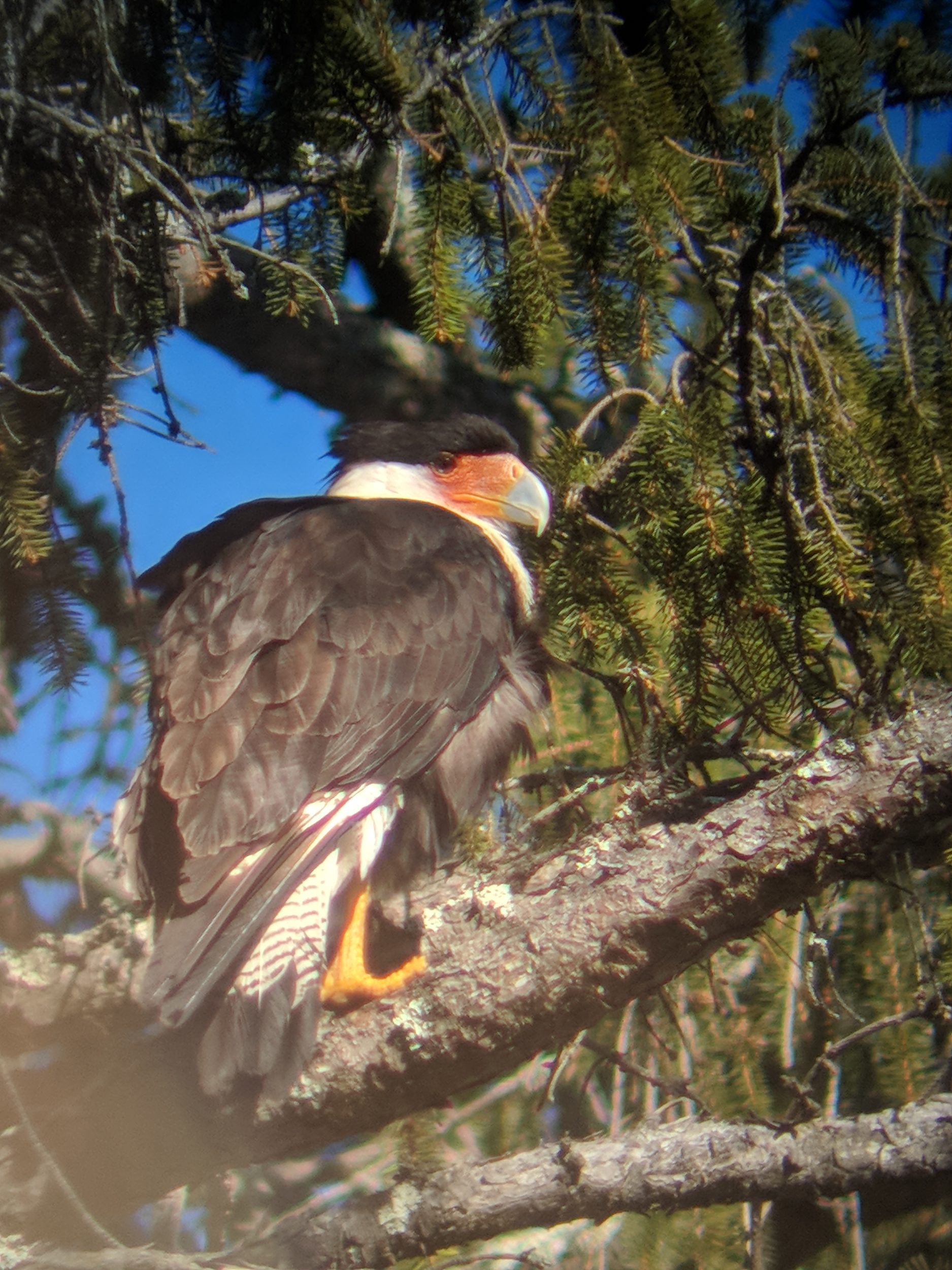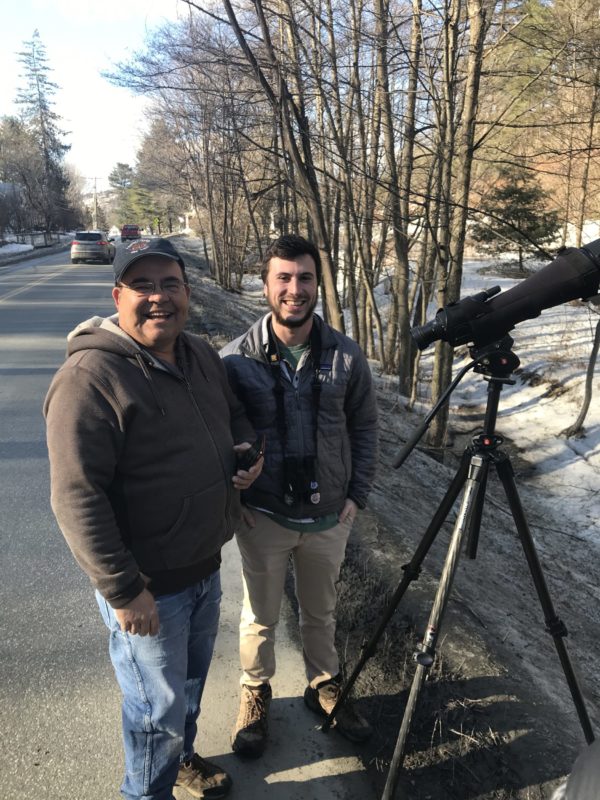
The Crested Caracara, photographed on the day it was first discovered near Billings Farm. © Sarah Carline
It all began with a Bald Eagle named Elvis.
On March 23, 2018 Mark Bessette surprised the Vermont iNaturalist community. Mark had snapped some photographs of an unusual-looking bird that he dubbed, “Elvis, the juvenile bald eagle.” The bird appeared to have a black wig that reminded Mark of the “King of Rock and Roll,” Elvis Presley. The iNaturalist community was quick to weigh in on the real identity of this bird. To seasoned birders, it easily stood out as a misplaced Crested Caracara, a scavenging relative of falcons native to Florida, the desert southwest, Mexico, and southward. While a detailed report of Mark’s encounter is forthcoming, it appears that this southern visitor constitutes a historic first record of this species in Vermont! Following hot on its heels, or talons in this case, was Vermont’s second record of Crested Caracara that has been delighting birders in Woodstock, VT over the past few days.
Known for their wandering, Crested Caracaras have very infrequently turned up in such far-flung places as New York, Maine, and even Nova Scotia. These surprise appearances, however, are not believed to result from migratory “overshooting,” as Crested Caracaras are a sedentary resident species throughout their range. Instead, it is thought that primarily young birds, and occasionally older individuals, disperse in search of new territories, occasionally flying remarkably long distances, perhaps being blown even further off course by strong weather patterns. These oddball birds that stray so far from home may be the pioneers ultimately leading to species’ range expansions over time—flying far and wide ensures finding new habitats, ecological niches and territories, some of which may provide suitable breeding opportunities. While climate change very likely plays a factor in the incremental range expansions northward of birds like Tufted Titmice and Northern Mockingbirds, or upslope in birds like the Blackpoll Warbler, far-ranging individual birds like the Vermont Crested Caracara, or Maine’s famous Great Black Hawk were likely driven by other as-yet unknown reasons.

Vermont’s second state record Crested Caracara perches on a spruce bough in Woodstock, soaking up the afternoon sun. © Nathaniel Sharp
It remains a mystery why, on March 4th in the late morning, Pomfret resident Kevin Rice came upon a bird that at first glance appeared quite similar to the aforementioned Elvis, coiffed hair and all. After snapping some photos from his car, he sent them immediately, with a thorough description of the bird’s field marks, to the Vermont Institute of Natural Science (VINS). I received a call from the fine folks at VINS about a potential Crested Caracara sighting shortly after arriving at the VCE office. One look at Kevin’s photos had me immediately rushing out the door to my car.
More often than not, rare birds likely pass by areas far from their native range unnoticed by humans, due to their unassuming plumage or similarity in appearance to common birds. The Crested Caracara is definitely not one of those birds. A minute or two after stepping out of my car near Woodstock’s Mt. Tom Farmer’s Market parking lot on Route 12 north, I walked past the surprisingly mild-smelling carcass of a Striped Skunk. Kevin had seen the caracara feeding on this roadkill earlier, so I knew I was in the right place. Turning around, I noticed a large black-and-white blob perched on a branch tucked in between a few spruce trees. Raising my binoculars to my face so fast I nearly gave myself two black eyes, I realized that I had Vermont’s second documented record of a Crested Caracara in my sights.

Kevin Rice, who first discovered and photographed the caracara, poses with Nathaniel Sharp, who documented the bird on Vermont eBird and spread the word to the VT birding community. ©Kent McFarland
My first order of business was to gaze in dumbfounded awe for a minute or two; the next was to verify that this was indeed a wild bird. Crested Caracaras are not a common species in the pet trade, and extremely infrequently held in captivity as either a falconer’s bird or a zoo animal, making the likelihood of this being a wild bird fairly high. Scanning up and down the bird’s long, stocky, orange legs used for strutting around through deserts and grasslands, I confirmed that there were no bands or falconer’s jesses that would signify this as an escaped captive. After taking a few photos to document this rare occurrence, I went through the bird from head to toe, carefully noting its field marks and adding them to my Vermont eBird report, which will soon lead to a Rare Species Documentation Form for the Vermont Bird Records Committee.
The bird’s field marks are unmistakably distinctive: a massive, silvery-blue bill bordered by flaming orange facial skin, the jet-black cap trailing into a wispy crest that blew back and forth in the cold gusts, the white breast and belly, speckled with black flecks reminiscent of “cookies and cream” ice cream, the white tail banded in black, and the jet black plumage on the wings and back, puffed up to defend the bird from the cold. Lastly, I was struck by those long, sturdy orange legs gripping its perch tightly, one occasionally disappearing into the belly feathers for warmth. These were the classic field marks of the “Mexican Eagle,” the national bird of Mexico, for now a resident of Woodstock, Vermont.

Nathaniel Sharp (bottom left) directs his spotting scope at the Crested Caracara (upper right) for a closer look as a brief snow squall blows through Woodstock. © Sarah Carline
After arriving at the site where the bird was spotted and thoroughly photographing and documenting it alongside VCE’s Sarah Carline, I set to work on getting the word out about this phenomenal bird. Knowing the excitement this would drum up in the Vermont birding community and even birders in nearby states, I distributed photos and information to the Vermont Birding Facebook page, the American Birding Association Rare Bird Alert page, and the VTBirds listserv. The tight-knit VT birding community responded quickly, and before too long birders from far and wide were able to see this visitor from the south as it sat in the warm glow of the sun in the spruce trees it has favored since its arrival.
I imagine that if this bird sticks around for much longer, it will begin to attract the attention of birders near and far, as it is certainly not every day (or year for that matter) that a Crested Caracara is seen anywhere in the Northeast. I encourage all who are interested in going to see this bird to check Vermont eBird and the VTBirds email listserv for details, park in the Mt. Tom Farmer’s Market lot to ease traffic flow, and keep a respectful distance from the bird so as not to further stress it. Rare birds like this also remind us all to review the ABA Code of Birding Ethics! I should also mention that, while this bird may not be accustomed to Vermont winter weather, it is a hardy species with a food and water source nearby in the form of road-killed animals and the Barnard Brook. In the shelter provided by the towering Norway Spruces and other trees throughout Woodstock, it is likely that if this bird does not leave the area soon, it could survive until spring arrives.
It remains to be seen whether this bird sticks around Woodstock or is a transient visitor, and whether it portends an increasing trend of vagrant Crested Caracaras in New England, or is simply one seriously lost individual. There is no question, however, that it has delighted many Vermont birders and brought curious passersby, however briefly, into the world of birdwatching and nature study.
VPR’s Mitch Wertlieb sat down with Nathaniel to chat about the significance of a Crested Caracara in Vermont, and what some of the drivers are behind bird vagrancy, listen here for the interview.

Great article, nice to see it return…
Good job!